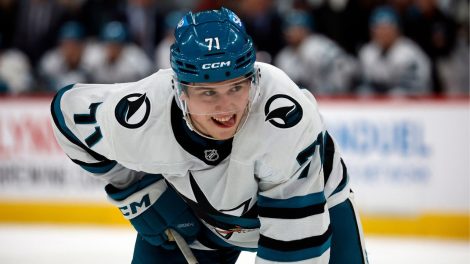New Vancouver Canucks centreman Brandon Sutter signed a lucrative five-year extension worth nearly $22 million on Tuesday.
It’s a big commitment for an NHL club to make for an unremarkable point producer — even if that unremarkable point producer is a six-foot-three defensive ace that plays a premium position.
The Canucks see Sutter as a crucial part of their long-term plans though. General manager Jim Benning even called Sutter a “foundation player” following the acquisition in late July.
The term was met with an incredulous reception from some corners of the hockey world. Sutter has never recorded more than 40 points in a season, after all, and he’s only twice managed to exceed 20 goals in a campaign.
The in-vogue statistical measurements do Sutter — and by extension, Benning — no favours either. The rate stats suggest that Sutter produces 5-on-5 offence at the rate typical of a fourth-line forward, while the shot-based metrics portray the Penguins as being regularly pinned in their own end of the rink when Sutter was on the ice over the past three seasons.
“Any time we make a trade we look at all the data that’s available to us,” Benning told Sportsnet on Wednesday. “But once you get past the data and you look at the intangibles, we look at things like, ‘Does the player that we’re going to acquire make players around him better?’
“With Brandon Sutter, he had 180 shots on net last year, so he’s a guy that generates shots,” continued Benning. “He uses his speed to get in on the forecheck. He has the courage to get to the net to get second and third opportunities to score.
“He’s a good young player, a player that scored 20 goals in the league last year… he’s going to bring us speed, his intangibles in the room, his leadership with our young group. We look at the whole picture when we’re making a trade of this magnitude.”
That “whole picture” extends to three years from now when Henrik and Daniel Sedin hang up their skates.
Not that Vancouver’s general manager expects Sutter to fill that starring first-line role. (Although he’s hopeful that the club’s new pivot can compete for a spot on the second line.) Benning doesn’t expect Luca Sbisa or Derek Dorsett, the other pedestrian point producers whom the Canucks have extended recently, to do so either.
“We play in a hard division and these guys make us harder to play against,” Benning said of his willingness to allocate cap space to non-scoring depth pieces. “They’re all guys that are physical. Dorsett led our team in hits last year and I think Luca was second, so they bring a physical element to our group. And Brandon is another guy who is going to play with intensity and focus.
“These are guys that are good in the room, they’re guys that are leaders, they’re guys that make other players around them better,” Benning continued. “We’re going to have some good young players coming in, guys that are going to be our skilled players, and our goal scorers, and the guys that produce. We want to make sure when these guys show up that they’re surrounded by the right players to make us a complete team.”
A complete team is a worthwhile ideal, but in the short- and long-term the existential question for the Canucks remains the same: after the Sedin twins, where is the offence going to come from?
Vancouver returned to the top-10 in NHL scoring last year, but the club leaned on a ton of empty-net goals to bolster their totals. The Canucks were likely to be a sub-average offensive team next season anyway, and the loss of productive depth contributors like Nick Bonino, Shawn Matthias and Zack Kassian could well exacerbate that issue.
Benning is counting on the organization’s youth to solve the issue.
“It was (Bo Horvat’s) first year in the league last year, so I expect him to score more goals,” Benning said.
“Sven Baertschi was our most skilled player in Utica after we traded for him; Ronalds Kenins was a guy who made his imprint with our team last year and I expect him to add more on the scoring side; if Jake Virtanen is able to make our team, I expect him to pick up some of the scoring. I believe we still have the same depth.”
Asked if the organization was concerned that their only assets signed through 2020 were non-scoring pieces like Chris Tanev and Sutter, Benning suggested that he wasn’t, in part because he’s confident that he can draft his way around the issue.
“We have some good young skill players coming,” Benning said, listing Virtanen, Brock Boeser and Jared McCann as examples. “That’s one thing with the draft we tried to concentrate on in the first-round, making sure that we drafted guys that are going to produce and score in the NHL.”
This repetitive focus on youth, it seems, is crucial here. To understand why the Canucks see Sutter as a foundation piece, you have to understand what Benning is trying to build.
That said, Benning’s Canucks have netted some iffy returns on the trade market and have made some poor value bets in doling out term and money to tertiary players.
If you’re struggling to make sense of the Sutter extension, or the Lack trade, or the Kassian swap, or any of the other head scratchers in Vancouver’s bouquet of seemingly discordant summer maneuvers, it’s at least useful context.








